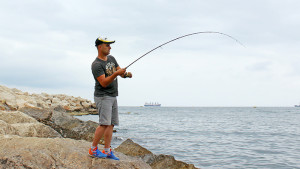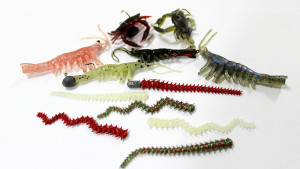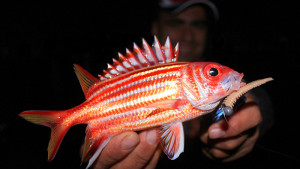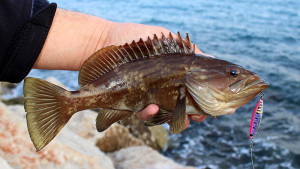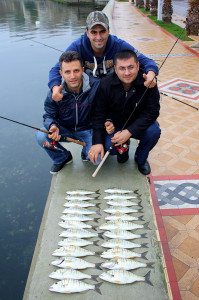Turkish Sea Fishing Delights
THE TURKISH FISHERMAN Savas Dursun has fished his whole life, and for the past five years he has spent massive amounts of time targeting salt water species from the rocky shores of his home waters near Antalya on the Southern coast of Turkey. During those five years, he has sampled 150 species, gained tons of important experience, and has even written a book on the subject of light rock fishing – a discipline he has fully championed.
I recently got the chance to talk to Savas about his Light Rock Fishing (LRF) experiences, and to delve deeper into what fascinates him about this particular style of fishing, which involves fishing the rocky coastal shores in search of diverse species.
How did you get started Light Rock Fishing?
My first LRF session was during the Spring of 2011. That was the first time I tried small 2.5gr jigheads with little worm type soft baits of less than 4cm – and, as usual, my target was the jack mackerel. Until the day I tried that, I was catching those fish by free spooling natural baits like shrimp, mussels, worms etc. But that day made a difference! I was now catching these fish with tiny lures and lightweight equipment, and suddenly, old-school bait fishing was history for me.
What is it that intrigues/fascinates you about LRF?
LRF is a very versatile method and the lure range is seemingly endless. The downsizing aspect makes LRF a technique that is ideal for a lot of species that would otherwise be impossible to catch. With this technique any species of fish is catchable and unlike most other forms of lure fishing, blank sessions are very rare – and it makes the technique great for newcomers to the sport.
What attracts me to this type of fishing is that the equipment is so light that I can feel every tug and headshake of any fish I catch. Even small quarries put up a good fight on the right LRF gear and it makes LRF fishing super-exciting and entertaining. Long story short: LRF is an enjoyable and easy way for anyone- from kids to seniors – to enjoy fishing, and actually catch something!
What kind of gear would you recommend for LRF and why?
LRF is the lightest form of lure fishing and it requires miniature lures. As a result, the rods and their actions must be chosen according to the lures. Two kinds of LRF rods are typically used: solid and tubular tip rods. Solid tip rods are more flexible and more resistant to bending, while tubular rods are fast action and more rigid and strong rods. When fishing for species of fish where you have to set the hook hard – and fight the fish with raw power – the tubular rods are recommended.
In most cases, the LRF lures used are jighead / soft bait combinations, and for this type of fishing 0-5g, 0.5-7g or similar rods of 180-230 cm in length are ideal. For faster fish, tubular rods with casting weights of 0-10g or 3-12g and lengths of about 180-270cm rods are more suitable. These rods also increase the casting range considerably.
The reels must be suitable for the LRF rods; typically sizes ranging from 500 – 2000, and for bigger fish 2500 size reels are ideal. If there is no need for fast retrieves, gear ratios between 5.1-5.3 are adequate. But if there is need for leverage and fast reeling, a gear ratio between 5.7-6.1 is a must.
In terms of lines, monofilament or fluorocarbon are the most used types in 0.10-0.16mm. In high-risk places with snags, boulders and sharp cliffs, and in places where bigger fish might be encountered, 0.20mm can be used. For feeling and sensitivity, spectra or PE braid lines can be used, but for invisibility, elasticity and absorption, mono and FC material should be used for a leader. In this case, 0.04mm braid should be coupled with a 0.16mm leader, and for a 0.10mm braid a 0.18mm leader and so on.
What are the most important factors in succeeding with LRF?
The success rate mainly depends on your knowledge of good LRF habitats and of the species, like “when, where, what they eat” etc. This way you can adjust your tackle and approach and make sure you’re at the right place at the right time. I personally like to fish in the wee hours of the day – early morning and late evening. And I also like to fish when the tides are shifting. Furthermore, I prefer places where deep water meets fairly shallow water; places with drastic drop-offs, plateaus and ocean floors with a variation of rocks, boulders and seaweed.
What coastal features do you pay attention to?
When I am choosing a spot to fish, I try to first consider what species I am targeting. But I must say, most species we target on LRF gear are smaller fish that are usually very abundant across different types of habitats, so selecting a fishing spot is generally easier than in predator fishing. I like to fish near structures such as piers, harbours, ports, marinas, estuarine habitats, mussel beds and weedy coves – these are all good LRF venues.
Wind and wind direction are usually the most critical criteria when I am choosing my fishing spot. This is due to the fact that headwinds or onshore winds radically decrease casting ability and range with light baits, jigheads etc. However, during the daytime, mild winds that churn up the shorelines a little offer great conditions for micro jigging.
Any key advice for people who would like to get started with LRF?
What I tell all newcomers to the LRF technique is that; “It’s not about catching big fish, it’s about catching whatever you can and having the most fun with it”. This technique provides us with fun and excitement– and it is readily available in most marine environments where you have rocky shorelines and drop-offs.
Interview + Photos by: Rasmus Ovesen

